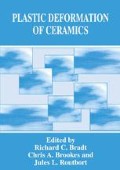Abstract
Hardness, an important property of materials, is traditionally determined by indentation testing and the measurement of the resulting contact area using optical microscopy. Often hardness needs to be measured on a very small scale, for example in the characterization of thin films, multiphase materials such as superconductors, and ion implanted surfaces. For indents generated at very low loads (<20 mN) or shallow depths (<250 nm), optical methods do not have sufficient resolution. One approach that avoids the limitations associated with optics involves the use of a mechanical properties microprobe (MPM). The MPM shown in Fig. 1 is a special microhardness tester which operates at very low loads (0.02 to 12 grams). The indent is made using a three-sided (Berkovich) diamond pyramid which has a face angle of 65.3° (with respect to the normal). The indenter load is generated electromagnetically and controlled by varying the current in the coil surrounding the indenter shaft. A capacitive sensor measures the indenter shaft displacement, which can be related to the contact area using the appropriate geometrical relationship for the indenter. Consequently, load and displacement can be continuously measured during the indentation process.
Research sponsored in part by the U.S. Department of Energy, Asst. Sec. for Energy Efficiency and Renewable Energy, Office of Transp. Technologies, as part of the High Temperature Materials Laboratory User Program, under contract DE-AC05-84OR21400 with Martin Marietta Energy Systems, Inc.
Access this chapter
Tax calculation will be finalised at checkout
Purchases are for personal use only
Preview
Unable to display preview. Download preview PDF.
References
P. J. Blau, J. R. Keiser, and R. L. Jackson, Materials Characterization 30 287–293 (1993).
W. C. Oliver and G. M. Pharr, J. Mater. Res., 7 [6] 1564–1583 (1992).
M. F. Doerner and W. D. Nix, J. Mater. Res. 1 [4] 601–609 (1986).
Author information
Authors and Affiliations
Editor information
Editors and Affiliations
Rights and permissions
Copyright information
© 1995 Springer Science+Business Media New York
About this chapter
Cite this chapter
Riester, L., Ferber, M.K. (1995). Investigation of Depth-Area Relationships Associated with Nanoindentations. In: Bradt, R.C., Brookes, C.A., Routbort, J.L. (eds) Plastic Deformation of Ceramics. Springer, Boston, MA. https://doi.org/10.1007/978-1-4899-1441-5_16
Download citation
DOI: https://doi.org/10.1007/978-1-4899-1441-5_16
Publisher Name: Springer, Boston, MA
Print ISBN: 978-1-4899-1443-9
Online ISBN: 978-1-4899-1441-5
eBook Packages: Springer Book Archive

